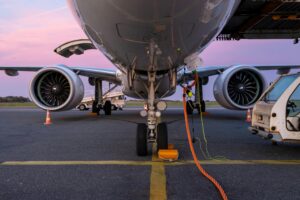Unlocking the Potential of African Aviation
The African sky, vast and boundless, holds a promise unfulfilled. Despite a continent teeming with 18% of the world’s population, African aviation accounts for a mere 2% of global air passenger traffic. The reasons are well-documented: fragmented regulations, protectionist policies, underfunded infrastructure, and a chronic shortage of skilled professionals. Yet, beneath these structural challenges lies a more insidious issue—a cycle of short-term profiteering that stifles progress. Whispers in boardrooms and policy circles suggest that some stakeholders benefit from perpetuating inefficiencies, reaping profits from repetitive transactions rather than fixing systemic problems. Is there truth to this claim? And if so, how can African aviation break free from this mental gridlock to unlock its immense potential?
The Cycle of Inefficiency
Imagine a small regional airport in a bustling African city. Its runways are cracked, its terminal outdated, and its air traffic control systems lag decades behind global standards. A proposal to refurbish the facility is tabled, but instead, a gleaming new airport is commissioned—a multi-million-dollar project promising jobs, prestige, and political capital. Years later, the new airport opens, but maintenance is neglected, and the cycle repeats. Across the continent, similar stories unfold: airlines replace aging aircraft rather than invest in maintenance, repair, and overhaul (MRO) facilities; governments protect loss-making carriers rather than liberalize markets; and contracts for quick fixes multiply while systemic issues fester.
This pattern isn’t mere coincidence. In African aviation, misaligned incentives often prioritize short-term gains over long-term value. State-owned airlines, which dominate over 60% of the continent’s carriers, are frequently shielded by restrictive Bilateral Air Service Agreements (BASAs). These agreements limit competition, keeping fares high and connectivity low—Africa’s intra-regional flights are among the world’s most expensive. Meanwhile, the absence of robust MRO infrastructure forces airlines to outsource maintenance to Europe or the Middle East, inflating costs and draining local economies. When new aircraft are purchased instead of maintaining existing fleets, or when airports are rebuilt rather than refurbished, the transactions generate immediate revenue for contractors, consultants, and political elites. The result? A self-perpetuating cycle where inefficiency becomes profitable.
This isn’t to say that every stakeholder deliberately sabotages progress. Africa’s aviation sector faces genuine constraints: low purchasing power, a vast landmass with dispersed populations, and regulatory fragmentation across 54 nations. Yet, the persistence of these issues—decades after the 1999 Yamoussoukro Decision (YD) promised to liberalize African airspace—suggests a deeper problem. The Single African Air Transport Market (SAATM), launched in 2018 to implement YD, has seen slow adoption, with only 34 countries signed up and fewer fully implementing it. Protectionism and short-termism, it seems, outweigh the collective vision of a connected continent.
A Global Parallel?
This cycle isn’t unique to Africa, though its impact is amplified by the continent’s economic and institutional challenges. Globally, aviation has seen similar patterns of inefficiency driven by vested interests. In the United States, the Federal Aviation Administration’s sluggish modernization of air traffic control systems has been mired in budget disputes and lobbying by contractors who profit from prolonged, piecemeal upgrades. In South Asia, infrastructure projects like roads and railways often face delays due to corruption in tender processes, with new contracts awarded instead of maintaining existing assets. Even in Europe, slot allocation at major airports favors incumbent airlines, stifling competition in ways that echo Africa’s restrictive BASAs.
The difference lies in resilience. Wealthier nations have stronger regulatory frameworks, greater public accountability, and access to capital that mitigate these tendencies. In Africa, where 12% of the global population lives on limited purchasing power, the stakes are higher. Aviation supports 6.9 million jobs and $80 billion in economic activity across the continent, yet its potential to drive trade, tourism, and connectivity remains untapped. The question is not whether the cycle exists—it does, in varying degrees—but how to break it.
The Cost of Inaction
Consider the numbers. Africa’s 740 airports and 420+ airlines operate in a market where intra-regional travel is prohibitively expensive, often costing more than transcontinental flights. A flight from Lagos to Accra, a mere 400 kilometers, can cost as much as a trip to London. This stifles demand, discourages investment, and perpetuates underdevelopment. Meanwhile, the lack of local MRO capacity means airlines spend billions outsourcing maintenance, while skilled jobs that could empower local economies are created elsewhere. The African Union’s Agenda 2063 envisions a connected continent, yet aviation—a critical enabler of that vision—remains stuck in a loop of short-term fixes.
The cost is not just economic but social. Emerging African megacities, from Lagos to Nairobi, are hubs of innovation and knowledge work. Yet, without efficient air connectivity, these cities struggle to integrate into global and regional economies. Tourism, a lifeline for countries like Kenya and Mauritius, suffers when flights are scarce or unaffordable. The promise of aviation as an economic multiplier—evident in the success of carriers like Emirates in boosting Dubai’s GDP—remains out of reach for most of Africa.
Breaking the Gridlock
So, how does African aviation escape this cycle? The answer lies in aligning incentives, building capacity, and fostering a mindset shift toward collective benefit over individual gain. Success stories within Africa offer a roadmap for what’s possible when the focus shifts from short-term transactions to long-term value.
Take Ethiopian Airlines, a beacon of what disciplined, commercially driven management can achieve. Unlike many of its state-owned peers, Ethiopian Airlines operates with operational independence, prioritizing efficiency over political agendas. Its investment in local MRO facilities, a world-class training academy, and a strategic hub in Addis Ababa has made it Africa’s largest and most profitable carrier. The airline’s success has ripple effects—Addis Ababa has become a gateway to Africa, connecting the continent to global markets and boosting Ethiopia’s economy. Similarly, Morocco’s open-skies policy has transformed its aviation sector, with tourist arrivals soaring and aviation contributing significantly to GDP growth. These examples prove that systemic reform, when paired with a vision for collective benefit, can break the cycle of stagnation.
Aligning Incentives for Progress
The first step in breaking this gridlock is to align incentives across stakeholders. Governments must recognize aviation as an economic multiplier, not a prestige project or a source of quick profits. High taxes on air tickets—historically justified as a way to “tax the rich”—need to be reconsidered. Reducing these costs can stimulate demand, as seen in markets like Mauritius, where Emirates’ flights have driven a tourism boom. Investments in local MRO facilities and training programs can create jobs, reduce dependency on foreign providers, and lower operational costs for airlines. The African Airlines Association (AFRAA) and the International Air Transport Association (IATA) have already initiated training programs to address skill gaps, but scaling these efforts requires political will and funding.
Transparency in procurement is equally critical. Too often, contracts for new airports or equipment purchases are mired in corruption, with inflated costs benefiting a select few. By implementing transparent bidding processes and anti-corruption measures, governments can rebuild trust and ensure that investments serve the public good. The African Development Bank could play a pivotal role here, tying loans for infrastructure projects to measurable reforms, such as the development of regional MRO hubs or the refurbishment of existing airports.
Building Capacity and Trust
Capacity building is the backbone of sustainable progress. Africa’s aviation sector suffers from a shortage of skilled professionals, from air traffic controllers to maintenance technicians. Establishing regional training centers, like the one Ethiopian Airlines operates, can address this gap. The International Civil Aviation Organization (ICAO) and IATA have already supported initiatives like the African Union’s Strategic Improvement Action Plan, which aims to enhance safety and operational efficiency. Workshops, such as the one held in Nairobi in March 2024 to advance the Yamoussoukro Decision, are steps in the right direction, but they must translate into actionable policies.
Trust is another critical factor. Stakeholders—governments, airlines, and private contractors—must believe that collective action will yield greater benefits than individual profiteering. This requires leadership that champions a pan-African vision, as envisioned by SAATM. Leaders must draw inspiration from global benchmarks, such as India’s rapid aviation growth, where the number of airports doubled from 76 to 153 in a decade, driving economic development. By showcasing the cost of inaction—Africa’s 2% share of global passenger traffic despite its population size—policymakers can be spurred to act.
A Mindset Shift Through Advocacy
Breaking the mental gridlock requires a cultural shift, one that reframes aviation as a public good rather than a luxury. Public awareness campaigns can play a pivotal role here. Citizens need to understand aviation’s economic impact—how it supports 6.9 million jobs and $80 billion in activity, and how it could do so much more. Grassroots advocacy, as seen in movements for open skies in other regions, can create pressure for reform, countering entrenched interests.
Data-driven storytelling is key. Highlighting how aviation has transformed economies—like Dubai’s growth through Emirates—can inspire a new narrative. In Mauritius, for instance, efficient air connectivity has made tourism a cornerstone of the economy, with ripple effects in hospitality, retail, and beyond. Similar stories from within Africa can shift the mindset from short-term self-interest to long-term collective gain.
The Path Forward?
The path forward is not without challenges, but it is clear. Start with incremental wins: pilot projects like regional MRO hubs or refurbished airports in key cities can demonstrate tangible benefits, building momentum for broader reform. External pressure from organizations like IATA and ICAO can help, tying funding to measurable progress. Most importantly, leadership must champion a pan-African vision, prioritizing connectivity and economic growth over political or financial gain.
Imagine a future where a flight from Lagos to Accra costs less than a trip to London, where local MRO facilities employ thousands of skilled workers, and where Africa’s 740 airports and 420+ airlines serve as engines of economic integration. This future is within reach, but it requires breaking the cycle of stagnation that has held African aviation back for decades. The answer lies in aligning incentives, building capacity, and fostering a mindset that values collective benefit over individual gain. Only then can the African sky fulfill its boundless promise.
Disclaimer: The insights shared in this article are for informational purposes only and do not constitute strategic advice. Aviation markets and circumstances vary, and decisions should be based on your organization’s specific context. For tailored consultancy and guidance, please contact info@avaerocapital.com.




